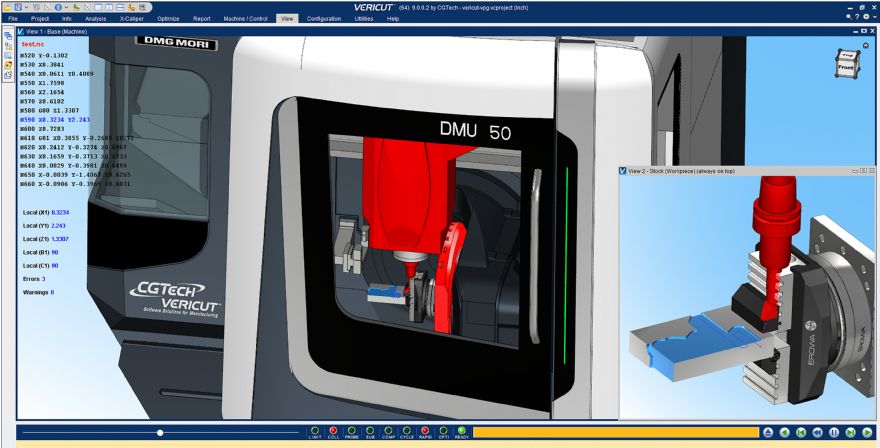
Hove-based
CGTech Ltd, which offers the Vericut NC-code simulation software, says that as machining gets more complex, the need to simulate, verify and optimise the machining process has become ever more necessary in order to ensure reliability, efficiency and maximised productivity.
The company adds that achieving the highest level of NC simulation and verification requires highly accurate ‘digital twin’ representations of the CNC machines, with these driven by the same post-processed G-code or NC programs that run the machine (a digital twin digitally replicates real world component manufacture processes within software).
CGTech says there are two critical items: first, are the virtual models correct and matching the physical ones; second, are the sub-routines and parameters from the machine tool being used.
“A key factor for simulation is making sure that the virtual models of all machine components — attachments, fixtures, clamps and cutting tools, for example — match as closely as possible to what is being used on the shopfloor in order to create the digital twin.
“The more accurate the simulation is the more reliable it will be in providing dependable outcomes. If short cuts are taken, like omitting input data, relying on ‘rough block’ size or using generic tools, it is likely that ‘surprises’, issues and errors will arise later. This is where Vericut’s connectivity plays a role.
“Also key is making sure the virtual machine uses parameters, sub-routines and probing logic taken from the actual machine tool, thereby making the digital twin behave exactly the same as the machine tool and its motions. Vericut can directly connect and communicate with multiple sources of software, including CAD/CAM, tool management systems and data from vendors and the cloud.
“This capability gives access to the most current information available and ensures that the virtual machine and simulation is as accurate as possible.”
CGTech also says that by using direct interfaces with all leading CAM systems, Vericut creates a seamless integration between the CAM system and simulation software — streamlining data flow, avoiding replication, eliminating human error and making the transfer for multiple set-ups and operations quick and easy.
“Furthermore, a variety of stock models, designs or finished parts and fixtures can be selected and imported into Vericut for simulation purposes, while connections to various tool management systems means Vericut can access a central source for cutting tool information — and obtain highly accurate tool models.
“Other information such as speeds and feeds can be brought into Vericut from a TDM system (tool data management) and used by programmers as a guideline to ensure that tools are not being over or under utilised — or as a starting point for optimising programs.”
Vericut also has various tools that streamline communication and connectivity throughout the manufacturing process. For example, reports can be configured to run automatically after the simulation; the system also offers a Reviewer file that can be opened by any Windows PC or tablet and allows users to view the full simulation.
“It is a 3-D representation of the simulation that can play forward and backward while removing and replacing material. The user can rotate, pan and zoom just like normal Vericut, and the cut stock can be measured using all the standard X-Caliper tools.
“Accurate simulation data means that the planning and scheduling department will have a better indication of cycle times, tool life information will be available for pre-setters, machinists will have confidence that the fixtures and programs are going to run correctly, NC programmers can be assured that the process is actually producing the part as intended, and process engineers and quality control can easily trace errors or issues in the design or NC program — and all this data can be collated before any actual machining is done.”
Vericut’s latest version
While the latest version of Vericut was released earlier this year, it continues to be improved and enhanced with additional incremental releases. Vericut 9 offers sharper displays, clearer views of the cutting process and better utilisation of the ‘system resources’, making it easier to spot problems and imperfections in machined parts.
It runs a lot of operations ‘multi-thread’ and makes use of GPUs (graphics processing units) that previous versions did not.
The biggest improvement visible to the end user is the ‘all open GL viewing environment’, which allows users to get optimal performance running simulations in a single view or multiple views, seamlessly switching between workpiece, machine, profile views or view layouts for enhanced viewing.
“Users no longer have to use individual views to perform each operation, resulting in a version that runs smoother and quicker than previous ones, while streamlining the ‘verification effort’ to increase productivity. Other enhancements mean users can automate many processes with just a click of a button. For example: check cutting limits; check spindle direction; check coolant; check syntax; and check tools. All these can be pre-set and saved in a master template, leaving Vericut to run the checks automatically.”
Also included are: Program preview, which quickly runs through a program without actually cutting the part, identifying machine crashes, fixture crashes and travel limit errors; a new Restart function that means there is no need to verify from the start of a program, only from the line where changes have been made (this will be a huge benefit for anyone verifying large NC programs); and ‘Air-Cuts only optimisation’, which allows users to optimise tool motions that are not in contact with material.
Furthermore, the Vericut Force module features enhanced charts for analysing cutting conditions, chip thickness and tool deflection.